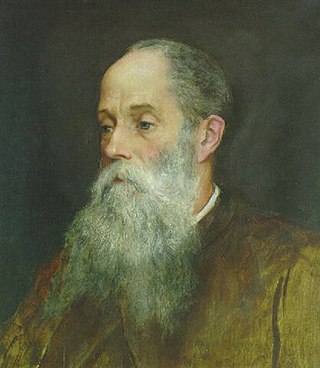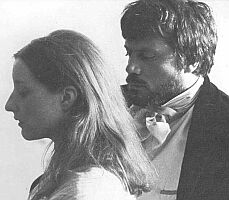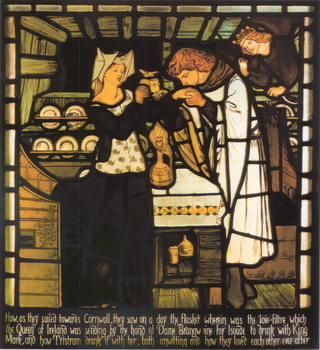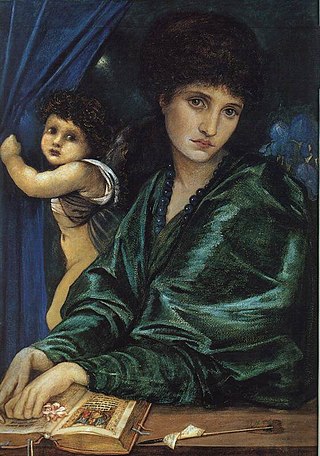
The Pre-Raphaelite Brotherhood (PRB), later known as the Pre-Raphaelites, was a group of English painters, poets, and art critics, founded in 1848 by William Holman Hunt, John Everett Millais, Dante Gabriel Rossetti, William Michael Rossetti, James Collinson, Frederic George Stephens and Thomas Woolner who formed a seven-member "Brotherhood" partly modelled on the Nazarene movement. The Brotherhood was only ever a loose association and their principles were shared by other artists of the time, including Ford Madox Brown, Arthur Hughes and Marie Spartali Stillman. Later followers of the principles of the Brotherhood included Edward Burne-Jones, William Morris and John William Waterhouse.

Gabriel Charles Dante Rossetti, generally known as Dante Gabriel Rossetti, was an English poet, illustrator, painter, translator, and member of the Rossetti family. He founded the Pre-Raphaelite Brotherhood in 1848 with William Holman Hunt and John Everett Millais. Rossetti inspired the next generation of artists and writers, William Morris and Edward Burne-Jones in particular. His work also influenced the European Symbolists and was a major precursor of the Aesthetic movement.

Sir Edward Coley Burne-Jones, 1st Baronet, was an English painter and designer associated with the Pre-Raphaelite Brotherhood's style and subject matter.

Jane Morris was an English embroiderer in the Arts and Crafts movement and an artists' model who embodied the Pre-Raphaelite ideal of beauty. She was a model and muse to her husband William Morris and to Dante Gabriel Rossetti. Her sister was the embroiderer and teacher Elizabeth Burden.

Fanny Cornforth was an English artist's model, and the mistress and muse of the Pre-Raphaelite painter Dante Gabriel Rossetti. Cornforth performed the duties of housekeeper for Rossetti. In Rossetti's paintings, the figures modelled by Fanny Cornforth are generally rather voluptuous, differing from those of other models such as Alexa Wilding, Jane Morris and Elizabeth Siddal.

John Roddam Spencer Stanhope was an English artist associated with Edward Burne-Jones and George Frederic Watts and often regarded as a second-wave pre-Raphaelite. His work is also studied within the context of Aestheticism and British Symbolism. As a painter, Stanhope worked in oil, watercolor, fresco, tempera, and mixed media. His subject matter was mythological, allegorical, biblical, and contemporary. Stanhope was born in Cawthorne, near Barnsley, Yorkshire, England, and died in Florence, Italy. He was the uncle and teacher of the painter Evelyn De Morgan and encouraged then unknown local artist Abel Hold to exhibit at the Royal Academy, which he did 16 times.

The Hogarth Club was an exhibition society of artists, based at 84 Charlotte Street, Fitzrovia, London, UK, which existed between 1858 and 1861. It was founded by former members of the Pre-Raphaelite Brotherhood after the original PRB had been dissolved. It was envisaged that the club would provide an alternative meeting space and exhibition venue to overcome prejudice against the Pre-Raphaelites at the Royal Academy. Unlike the PRB, the Hogarth Club was established on a professional basis, with two classes of members, artistic and non-artistic, and a distinction between London-based "resident" and provincial "non-resident" members.

William Graham, Liberal MP for Glasgow, was a Scottish politician, wine merchant, cotton manufacturer and port shipper. He is remembered as a patron of Pre-Raphaelite artists like Edward Burne-Jones and Dante Gabriel Rossetti and a collector of their works.

Desperate Romantics is a six-part television drama serial about the Pre-Raphaelite Brotherhood, first broadcast on BBC Two between 21 July and 25 August 2009.

The Oxford Union murals (1857–1859) are a series of mural decorations in the Oxford Union library building. The series was executed by a team of Pre-Raphaelite artists including Dante Gabriel Rossetti, William Morris and Edward Burne-Jones. The paintings depict scenes from Arthurian myth.

Dante's Inferno: The Private Life of Dante Gabriel Rossetti, Poet and Painter is a 1967 British 35 mm docudrama film directed by Ken Russell and first screened on BBC1 on 22 December 1967 as part of Omnibus. It quickly became a staple in cinemas in retrospectives of Russell's work.

The Tristram and Isoude stained glass panels are a series of 13 small stained-glass windows made in 1862 by Morris, Marshall, Faulker & Co. for Harden Grange, the house of textile merchant Walter Dunlop, near Bingley in Yorkshire, England. Depicting the legend of Tristan and Iseult, they were designed by six of the leading Pre-Raphaelite artists of the day, to an overall design by William Morris. They were acquired in 1917 by Cartwright Hall Art Gallery, which is now part of Bradford Museums & Galleries. They can be seen on display at Cliffe Castle, Keighley.

Maria Zambaco, born Marie Terpsithea Cassavetti, was a British artist's model of Greek descent, favoured by the Pre-Raphaelites. She was also a sculptor.

Aglaia Coronio was a British embroiderer, bookbinder, art collector and patron of the arts.

Pia de' Tolomei is an oil painting on canvas by English artist Dante Gabriel Rossetti, painted around 1868 and now in the Spencer Museum of Art, on the campus of the University of Kansas in Lawrence, Kansas.

Proserpine is an oil painting on canvas by English artist and poet Dante Gabriel Rossetti, painted in 1874 and now in Tate Britain. Rossetti began work on the painting in 1871 and painted at least eight separate versions, the last only completed in 1882, the year of his death. Early versions were promised to Charles Augustus Howell. The painting discussed in this article is the so-called seventh version commissioned by Frederick Richards Leyland, now at the Tate Gallery, with the very similar final version now at the Birmingham Museum and Art Gallery.

Paolo and Francesca da Rimini is a watercolour by British artist and poet Dante Gabriel Rossetti, painted in 1855 and now in Tate Britain. The painting is a triptych inspired by Canto V of Dante's Inferno, which describes the adulterous love between Paolo Malatesta and his sister-in-law Francesca da Rimini. The left- and right-hand panels both show the lovers together; the central panel shows Dante and the Roman poet Virgil, who guides Dante through hell in the poem.

Thoughts of the Past is an oil painting on canvas by English Pre-Raphaelite artist John Roddam Spencer Stanhope, first exhibited in 1859 and currently housed at Tate Britain.

George Rae was a British banker, Pre-Raphaelite Art Collector, author, businessman, Parliamentary lobbyist, traveler and benefactor based in Liverpool, Birkenhead, and Oxton, Merseyside. He worked for The North and South Wales Bank between 1839 and 1898. He is known for his Pre-Raphaelite Art collection, being a patron of Dante Gabriel Rossetti, as well as his friendship with William Morris. He published two books on banking, The Internal Management of a Country Bank (1850) and The Country Banker, His Clients, Cares and Work' (1885). He was a founding trustee of the Institute of Bankers.

Love Among the Ruins is a painting by English artist Edward Burne-Jones which exists in two versions, a watercolour completed in 1873 and an oil painting completed in 1894. It depicts a man and a woman amid ruined architecture. The work is a synthesis of influences from the Pre-Raphaelite, Symbolist and Aesthetic art movements. The ambiguous scene without a clear narrative is considered one of Burne-Jones' best works.



















